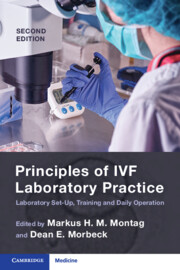Book contents
- Principles of IVF Laboratory Practice
- Principles of IVF Laboratory Practice
- Copyright page
- Contents
- Contributors
- Foreword
- The Evolution of IVF Practice
- Section 1 Starting a New Laboratory and Training Protocols
- Section 2 Pre-procedure Protocols
- Section 3 Gametes
- Section 4 Insemination/ICSI
- Chapter 21 General Insemination for IVF
- Chapter 22 Conventional IVF with Short Co-incubation
- Chapter 23 Technical Aspects of ICSI for Ejaculated Spermatozoa
- Chapter 24 Set-Up and Adapted Protocol for Piezo-ICSI
- Chapter 25 Sperm Selection for ICSI by Morphology
- Chapter 26 Sperm Selection for ICSI by Viability
- Chapter 27 Artificial Oocyte Activation for IVF
- Section 5 Fertilization Assessment
- Section 6 Embryo Assessment: Morphology and Beyond
- Section 7 Embryo Cryopreservation
- Section 8 Embryo Transfer
- Section 9 Quality Management
- Index
- References
Chapter 22 - Conventional IVF with Short Co-incubation
from Section 4 - Insemination/ICSI
Published online by Cambridge University Press: 07 August 2023
- Principles of IVF Laboratory Practice
- Principles of IVF Laboratory Practice
- Copyright page
- Contents
- Contributors
- Foreword
- The Evolution of IVF Practice
- Section 1 Starting a New Laboratory and Training Protocols
- Section 2 Pre-procedure Protocols
- Section 3 Gametes
- Section 4 Insemination/ICSI
- Chapter 21 General Insemination for IVF
- Chapter 22 Conventional IVF with Short Co-incubation
- Chapter 23 Technical Aspects of ICSI for Ejaculated Spermatozoa
- Chapter 24 Set-Up and Adapted Protocol for Piezo-ICSI
- Chapter 25 Sperm Selection for ICSI by Morphology
- Chapter 26 Sperm Selection for ICSI by Viability
- Chapter 27 Artificial Oocyte Activation for IVF
- Section 5 Fertilization Assessment
- Section 6 Embryo Assessment: Morphology and Beyond
- Section 7 Embryo Cryopreservation
- Section 8 Embryo Transfer
- Section 9 Quality Management
- Index
- References
Summary
Since the advent of in vitro fertilization (IVF), conventional insemination has remained essentially unchanged and for most IVF laboratories involves overnight co-incubation of sperm with oocytes. Optimization of insemination methods to better mimic in vivo conditions may achieve better embryo quality and clinical outcomes. A short insemination protocol is one method that addresses this divergence. Studies on a short insemination protocol (1–4 hours instead of 15–20 hours) demonstrate similar fertilization rate, embryo cleavage rates and pregnancy rates. Since human sperm capacitation requires only 45 minutes of contact between oocytes and spermatozoa, these observations are not unexpected. These findings and the information presented in this chapter illustrate that short insemination is an effective method for IVF that, further- more, provides benefits for programmes using time-lapse (TL) imaging. While historically only intracytoplasmic sperm injection (ICSI) oocytes can be observed for fertilization with TL imaging, short co-incubation insemination facilitates early TL culture for all IVF cycles, making early-morning fertilization checks obsolete and freeing staff to perform other duties. Furthermore, TL imaging affords the advantage of identifying oocytes that show normal fertilization outside the standard window of time used for fertilization assessment.
- Type
- Chapter
- Information
- Principles of IVF Laboratory PracticeLaboratory Set-Up, Training and Daily Operation, pp. 166 - 169Publisher: Cambridge University PressPrint publication year: 2023



